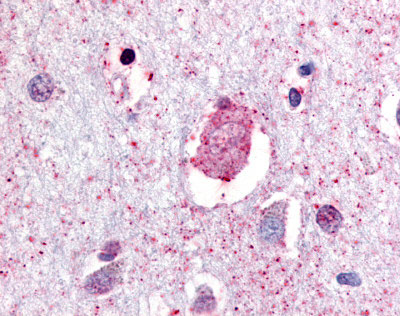GPR88 Antibody (C-Terminus)
Rabbit Polyclonal Antibody
- SPECIFICATION
- CITATIONS
- PROTOCOLS
- BACKGROUND

Application
| IHC-P |
|---|---|
| Primary Accession | Q9GZN0 |
| Reactivity | Human, Mouse, Rabbit, Monkey, Pig |
| Host | Rabbit |
| Clonality | Polyclonal |
| Calculated MW | 40kDa |
| Dilution | IHC-P (12-23 µg/ml) |
| Gene ID | 54112 |
|---|---|
| Other Names | Probable G-protein coupled receptor 88, Striatum-specific G-protein coupled receptor, GPR88, STRG |
| Target/Specificity | Human GPR88. BLAST analysis of the peptide immunogen showed no homology with other human proteins. |
| Reconstitution & Storage | Long term: -70°C; Short term: +4°C |
| Precautions | GPR88 Antibody (C-Terminus) is for research use only and not for use in diagnostic or therapeutic procedures. |
| Name | GPR88 |
|---|---|
| Synonyms | STRG |
| Function | Orphan G protein-coupled receptor implicated in a large repertoire of behavioral responses that engage motor activities, spatial learning, and emotional processing (By similarity). May play a role in the regulation of cognitive and motor function (By similarity). Couples with the heterotrimeric G protein complex of the G(i) subfamily, consisting of GNAI1, GNB1 and GNG2, thereby acting through a G(i)-mediated pathway (PubMed:35501348). Plays a role in the attenuation of D1 dopamine receptor (D1R)-mediated cAMP response in ciliated cells (PubMed:23936473). In non-ciliated cells, involved in the inhibition of the beta-2 adrenergic receptor (B2AR) response (PubMed:23936473). |
| Cellular Location | Cell membrane {ECO:0000250|UniProtKB:Q9ESP4}; Multi-pass membrane protein. Cell projection, cilium membrane; Multi-pass membrane protein. Cytoplasm {ECO:0000250|UniProtKB:Q9ESP4}. Nucleus {ECO:0000250|UniProtKB:Q9ESP4}. Note=Localized to cilia in ciliated cells; whereas in non-ciliated cells, distributed throughout the cell membrane (PubMed:23936473). During cortical lamination, subcellular location shifts, on the day of birth, from expression at the plasma membrane and in the cytoplasm to the nuclei of neurons. This intranuclear localization remains throughout adulthood {ECO:0000250|UniProtKB:Q9ESP4, ECO:0000269|PubMed:23936473} |
| Tissue Location | Expressed predominantly in the striatum. |
| Volume | 50 µl |

Thousands of laboratories across the world have published research that depended on the performance of antibodies from Abcepta to advance their research. Check out links to articles that cite our products in major peer-reviewed journals, organized by research category.
info@abcepta.com, and receive a free "I Love Antibodies" mug.
Provided below are standard protocols that you may find useful for product applications.
Background
Orphan receptor.
References
Mizushima K.,et al.Genomics 69:314-321(2000).
Kopatz S.A.,et al.Submitted (JUL-2003) to the EMBL/GenBank/DDBJ databases.
Gregory S.G.,et al.Nature 441:315-321(2006).
If you have used an Abcepta product and would like to share how it has performed, please click on the "Submit Review" button and provide the requested information. Our staff will examine and post your review and contact you if needed.
If you have any additional inquiries please email technical services at tech@abcepta.com.













 Foundational characteristics of cancer include proliferation, angiogenesis, migration, evasion of apoptosis, and cellular immortality. Find key markers for these cellular processes and antibodies to detect them.
Foundational characteristics of cancer include proliferation, angiogenesis, migration, evasion of apoptosis, and cellular immortality. Find key markers for these cellular processes and antibodies to detect them. The SUMOplot™ Analysis Program predicts and scores sumoylation sites in your protein. SUMOylation is a post-translational modification involved in various cellular processes, such as nuclear-cytosolic transport, transcriptional regulation, apoptosis, protein stability, response to stress, and progression through the cell cycle.
The SUMOplot™ Analysis Program predicts and scores sumoylation sites in your protein. SUMOylation is a post-translational modification involved in various cellular processes, such as nuclear-cytosolic transport, transcriptional regulation, apoptosis, protein stability, response to stress, and progression through the cell cycle. The Autophagy Receptor Motif Plotter predicts and scores autophagy receptor binding sites in your protein. Identifying proteins connected to this pathway is critical to understanding the role of autophagy in physiological as well as pathological processes such as development, differentiation, neurodegenerative diseases, stress, infection, and cancer.
The Autophagy Receptor Motif Plotter predicts and scores autophagy receptor binding sites in your protein. Identifying proteins connected to this pathway is critical to understanding the role of autophagy in physiological as well as pathological processes such as development, differentiation, neurodegenerative diseases, stress, infection, and cancer.


